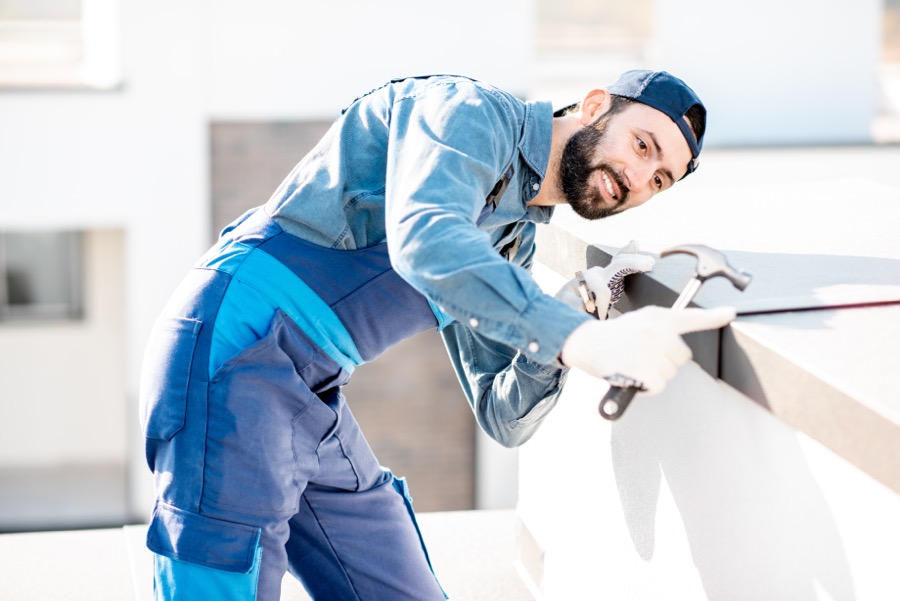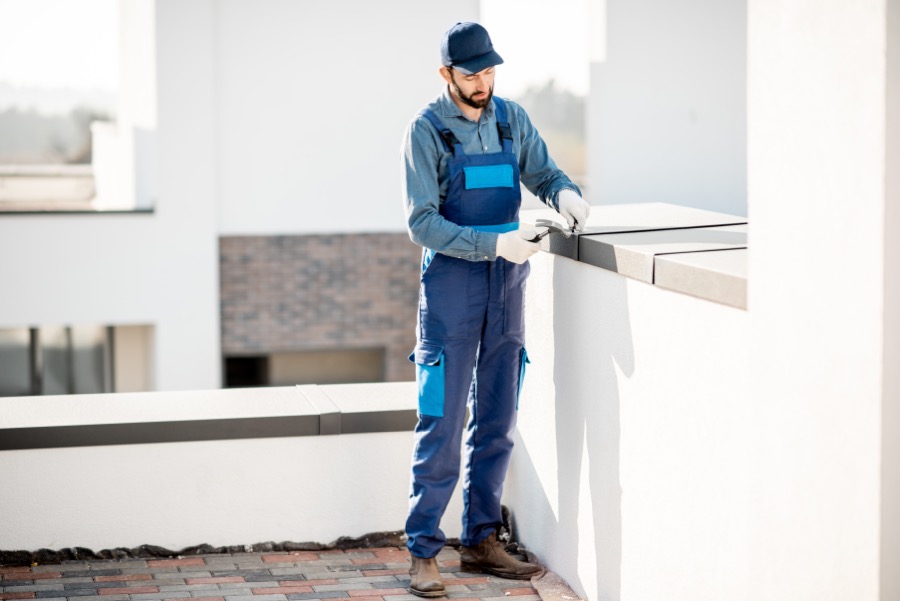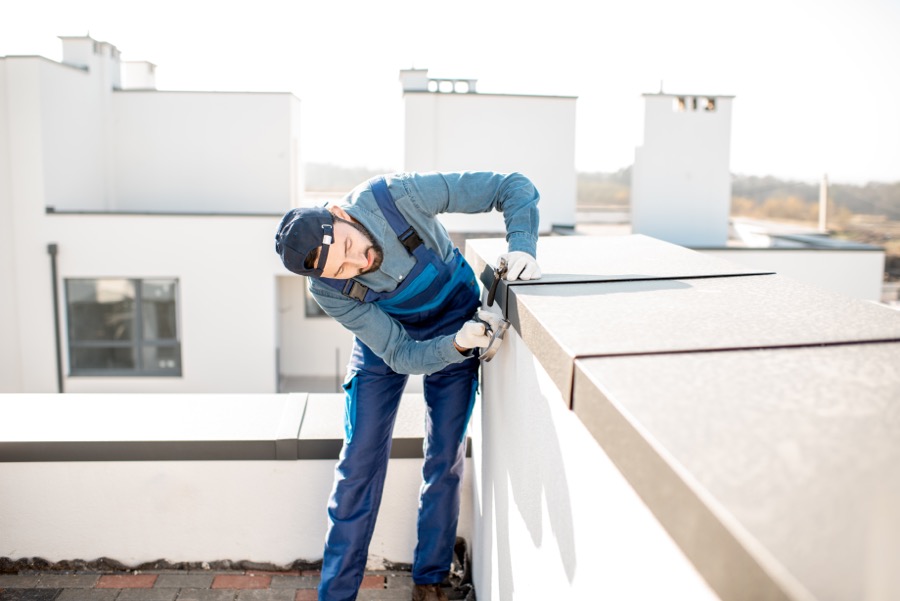
Home > Blog posts > Roof parapet: what is it and what is it use for?
Roof parapet: what is it and what is it use for?
Several buildings with smaller roofs have one, but very little people stop to think about how it is built: what is a roof parapet and what is it used for? Find out more about this structural element that probably has many more uses than you might think, including improving esthetics and protection.
What is the parapet on a roof?
The parapet is a structure that is almost like an extension of the roof, but a bit higher. It is a structural element that can be found on sloped and flat roofs alike.
In the first case, it is placed above the gutters. In the second, it is generally a vertical extension of the roof or the wall. It is often impossible to determine the existence of a parapet on a flat roof from the outside, since it merges with the façade.
The height of the parapet is at least 45 cm, but it can also be higher in order to protect people walking on the roof. The parapet can even reach higher than one meter, and can include a barrier, trim or border.
Although it can be different from one building to another, all parapets share a common structure and have more or less the same components, including the main part called the shelf.
From this main part another part reaches up, called “overhang”, which is perpendicular to the first. There are also scuppers, which are placed to the sides and allow water to be evacuated away from the roof and the façade. This part plays an important role in protecting the exterior wall; we will come back to these structural elements and how they work.
Contact us now for a roof inspection

Why install a parapet?
Nowadays, a parapet is mostly used as a safety system and to help avoid falls, as long as it is high enough. A parapet that is less than one meter will not be sufficiently high to protect you from falls, although it can be combined with other safety elements.
It is mandatory to have a protective element to protect from falls on any building that is higher than three meters high. A railing might be the only solution you had in mind, but a parapet also represents an interesting option. In fact, finding a way to install this type of protection while also figuring out an esthetically pleasing solution is a great reason to opt for a parapet.
However, parapets are even more versatile! And installing one can also offer great overall protection for your building, especially from the rain. As we have seen, scuppers will drive water away from the façade. This will help you avoid erosion and degradation of the building materials due to rain water or melted ice or snow.
Because the parapet is elevated, it will also provide you with more intimacy. If you have a rooftop terrace, this will give you the opportunity of enjoying it fully without being exposed to your surroundings, which is a significant advantage.
If you have equipment or devices on your roof, they will also be hidden from onlookers! Whether it is simply for more intimacy or for the most visually esthetic option, the parapet is very useful.
Considering the protective element –both for you and your guests and also your building- and the esthetic aspect, there are several excellent reasons to install a parapet.

What is a parapet used for?
The parapet is a structural element that has existed for hundreds of years, and was originally used to protect individuals during battles. If you look at period movies, you have probably already seen soldiers attack and hide behind this type of roof structure.
However, the parapet was also invented by architects for esthetic reasons. This is why there are so many different styles of parapets in Europe. Nowadays, the parapet has maintained this esthetic function, although the modern style is completely different.
Although the risks of you going into battle are slim, the parapet still plays an important role in terms of protection. Today, it will protect you mostly from falls, and natural elements such as water, wind and even fires.
So, the parapet has evolved with the times in order to provide you with the best of what it has to offer. However, it is essential that it be properly installed, otherwise it will cause infiltrations instead of preventing them!
As you can see, parapets have been further developed to fulfill our modern needs.

Characteristics and uses of a parapet for your roof
The materials used to build a parapet are varied, and depend on the building’s structure. It can be made of:
- Metal
- Reinforced or full concrete
- Bricks
Moreover, the parapet is often covered with an apron, which can also be made from several different materials, mainly metal. This element will be set away from the inside structure with a space of at least ¾ to 1 inch.
The metallic protection panels have a thickness of 0.3 to 0.7 mm and are available in several styles (simple, flat, complex, etc.). In short, this component will influence the esthetic look of the parapet and its features. Cornices and guardrails can also be added as decorative elements.
When a parapet is being installed, it is important to ensure the junction between the roof and the parapet by placing a reinforced sealing layer. The insulation of a parapet for a flat roof is essential in order to prevent infiltrations. A side wall set at 45 degrees between the roof and the parapet can also be an effective option to limit the risks of damages done to the roof.
When the parapet is well made, it can fulfill its functions properly, including the protection from damages related to natural elements. In fact, this type of wall set above your roof can stop fire from spreading.
Moreover, the parapet can even out pressure during strong winds. In fact, strong wind gusts can be very damaging to your roof, causing it to tear. The parapet will stop them from reaching your roofing and diminish their force.
Amongst the other uses, let’s also mention that it prevents debris and branches from falling onto the roof, especially when it is windy.
In short, the parapet protects your flat roof and can constitute a significant esthetic asset. For a perfectly sealed flat roof or a new construction, do not hesitate to contact our team of passionate experts at La Clinique de la toiture FCA.
Don't wait any longer: ask us for a quote!
Get an estimate in just 2 quick steps!
*Please allow a minimum of 24 hours for your request to be processed. Thank you for your understanding!
Need help?
Leave us your email address and we will contact you as soon as possible to assess your needs!
Put an end to your water infiltration your clogged drains your roof problems
Leave us your email address and we will contact you as soon as possible to assess your needs!
